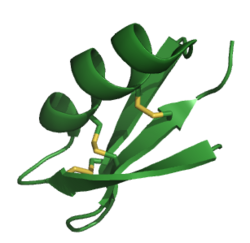| Scorpion long-chain toxin | |||||||||
|---|---|---|---|---|---|---|---|---|---|
 Crystal structure of toxin II from the scorpion Androctonus australis Hector. [1] | |||||||||
| Identifiers | |||||||||
| Symbol | Toxin_3 | ||||||||
| Pfam | PF00537 | ||||||||
| InterPro | IPR002061 | ||||||||
| SCOP2 | 2sn3 / SCOPe / SUPFAM | ||||||||
| TCDB | 8.B.1 | ||||||||
| OPM superfamily | 58 | ||||||||
| OPM protein | 1djt | ||||||||
| |||||||||
| Scorpion short toxin | |||||||||
|---|---|---|---|---|---|---|---|---|---|
 | |||||||||
| Identifiers | |||||||||
| Symbol | Toxin_2 | ||||||||
| Pfam | PF00451 | ||||||||
| Pfam clan | CL0054 | ||||||||
| InterPro | IPR001947 | ||||||||
| PROSITE | PDOC00875 | ||||||||
| TCDB | 8.B.2 | ||||||||
| OPM superfamily | 58 | ||||||||
| OPM protein | 1ne5 | ||||||||
| |||||||||
Scorpion toxins are proteins found in the venom of scorpions. Their toxic effect may be mammal- or insect-specific and acts by binding with varying degrees of specificity to members of the Voltage-gated ion channel superfamily; specifically, voltage-gated sodium channels, voltage-gated potassium channels, [3] and Transient Receptor Potential (TRP) channels. [4] [5] The result of this action is to activate or inhibit the action of these channels in the nervous and cardiac organ systems. For instance, α-scorpion toxins MeuNaTxα-12 and MeuNaTxα-13 from Mesobuthus eupeus are neurotoxins that target voltage-gated Na+ channels (Navs), inhibiting fast inactivation. In vivo assays of MeuNaTxα-12 and MeuNaTxα-13 effects on mammalian and insect Navs show differential potency. These recombinants (MeuNaTxα-12 and MeuNaTxα-13) exhibit their preferential affinity for mammalian and insect Na+ channels at the α-like toxins' active site, site 3, in order to inactivate the cell membrane depolarization faster[6]. The varying sensitivity of different Navs to MeuNaTxα-12 and MeuNaTxα-13 may be dependent on the substitution of a conserved Valine residue for a Phenylalanine residue at position 1630 of the LD4:S3-S4 subunit or due to various changes in residues in the LD4:S5-S6 subunit of the Navs. [6] Ultimately, these actions can serve the purpose of warding off predators by causing pain (e.g., through the activation of sodium channels or TRP channels in sensory neurons) [7] or to subdue predators (e.g., in the case of inhibition of cardiac ion channels). [8]
Contents
The family includes related short- and long-chain scorpion toxins. It also contains a group of proteinase inhibitors from the plants Arabidopsis thaliana and Brassica spp.
The Brassica napus (oil seed rape) and Sinapis alba (white mustard) inhibitors, [9] [10] inhibit the catalytic activity of bovine beta-trypsin and bovine alpha-chymotrypsin, which belong to MEROPS peptidase family S1 (InterPro : IPR001254 ). [11]
This group of proteins is now used in the creation of insecticides, vaccines, and protein engineering scaffolds.